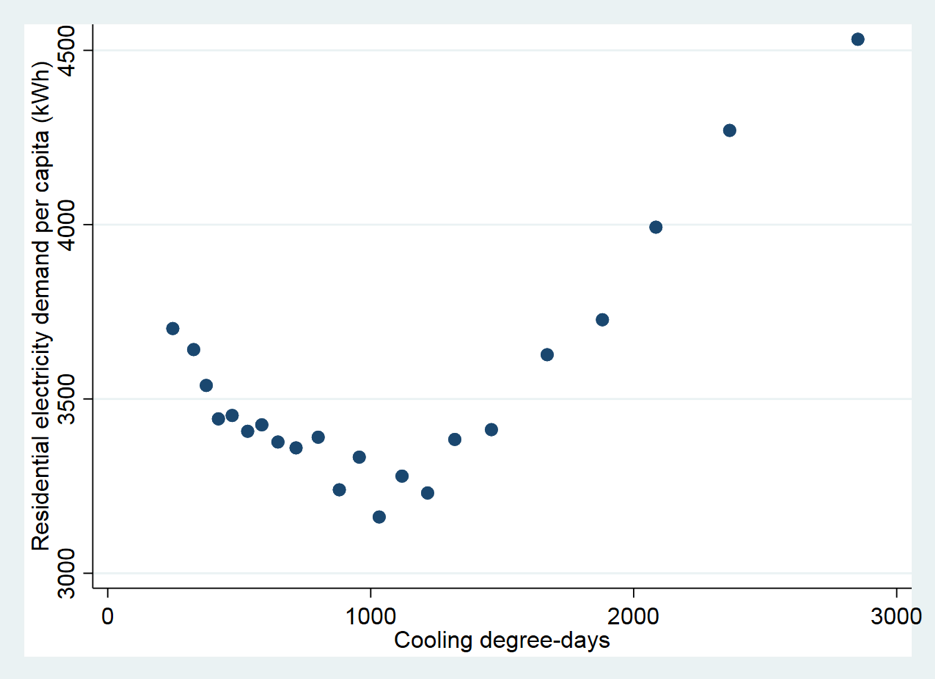
Is air conditioning the cure to our increasingly warmer summers?
In 1958 when residential air conditioning (A/C) was first entering American homes, Eddie Cochran famously wrote the line 'there ain't no cure for the summertime blues' in his hit song Summertime Blues. Nowadays, for most Americans, the only cure for the summertime blues and the season's blistering temperatures is to turn on the A/C, fans, and other cooling devices.
According to the 2015 Residential Energy Consumption Survey conducted by the U.S. Energy Information Administration (EIA), 87% of homes in the United States use air conditioning at an average annual operating cost of $265. This amounts to 12% of total home energy expenditures.
These private expenditures on electricity deliver a host of benefits to American consumers, including increased comfort (obviously), reductions in mortality risks, and even improved PSAT scores. As our summers become increasingly hotter, we will likely spend more of our resources on electricity and energy consumption. This tradeoff illustrates the ways we are able to adapt to a changing climate and mitigate the negative effects of warmer temperatures. But importantly, it also highlights that adaptation is costly. For several years, I've been working to estimate just how costly future climate change adaptation might be.
In 2011, Michael Greenstone and I used data on total residential energy consumption from the EIA and historical weather data to empirically estimate the relationship between temperatures and energy consumption in the United States. Like many other studies on this topic, we found that higher temperatures significantly increase residential energy consumption [for examples of other studies, see here, and here].
The figure below illustrates the temperature-electricity demand curve by plotting annual residential electricity demand per capita against cooling degree days with a base of 65 F (a standard measure of cooling demand in energy models). This analysis controls for other predictors of demand, including state of residence and year fixed effects.

Our 2011 study also reported the first data-driven estimates of the additional residential energy costs predicted under future climate change scenarios. Using a method that accounted for both the increase in cooling demand and the decrease in heating demand, we found that between 2010-2099, residential energy consumption will increase by a net 90 quadrillion British thermal units (QBTU) due to shifts in the temperature distribution. For comparison, in 2018, residential energy consumption was 21.6 QBTU in the United States. At the current energy price, the cost of an additional 90 QBTUs is approximately $500 billion.
I am currently updating and expanding the scope of the 2011 study, and recently I presented my preliminary results at a keynote lecture at the Seoul Workshop in Energy Economics. These results suggest that residential electricity demand has been increasing in response to the higher temperatures over the last few decades. In other words, the temperature-demand curve captured in the figure above is only getting steeper. Back in the 1970s and early 1980s, an increase in base 65 F cooling degree days of 100 units (the U.S. average is roughly 1,250) would increase residential electricity consumption by 0.8%. By the 2000s and 2010s, the electricity demand response to the same heat shock had almost doubled to 1.4%.
This means that as our summers continue to warm, the cost we pay to adapt to rising temperatures is also going to rise. What's more, the consumption of additional electricity also imposes large social costs on local communities and the world at large due to increased emissions of CO2 and other harmful pollutants by fossil-fueled power plants.
We expect that the private and external costs of adaptation will only continue to increase over time, as the roughly three billion people currently living in the warmest and less-adapted regions of the world (Brazil, China, Indonesia, and India, to name a few) grow richer and start buying and using energy-intensive cooling technologies like air conditioning.
Unless we can develop low energy cooling technologies, quickly decarbonize the electricity generation sector, or price energy more efficiently, air conditioning will keep cooling our summertime blues, but at a very high cost.



